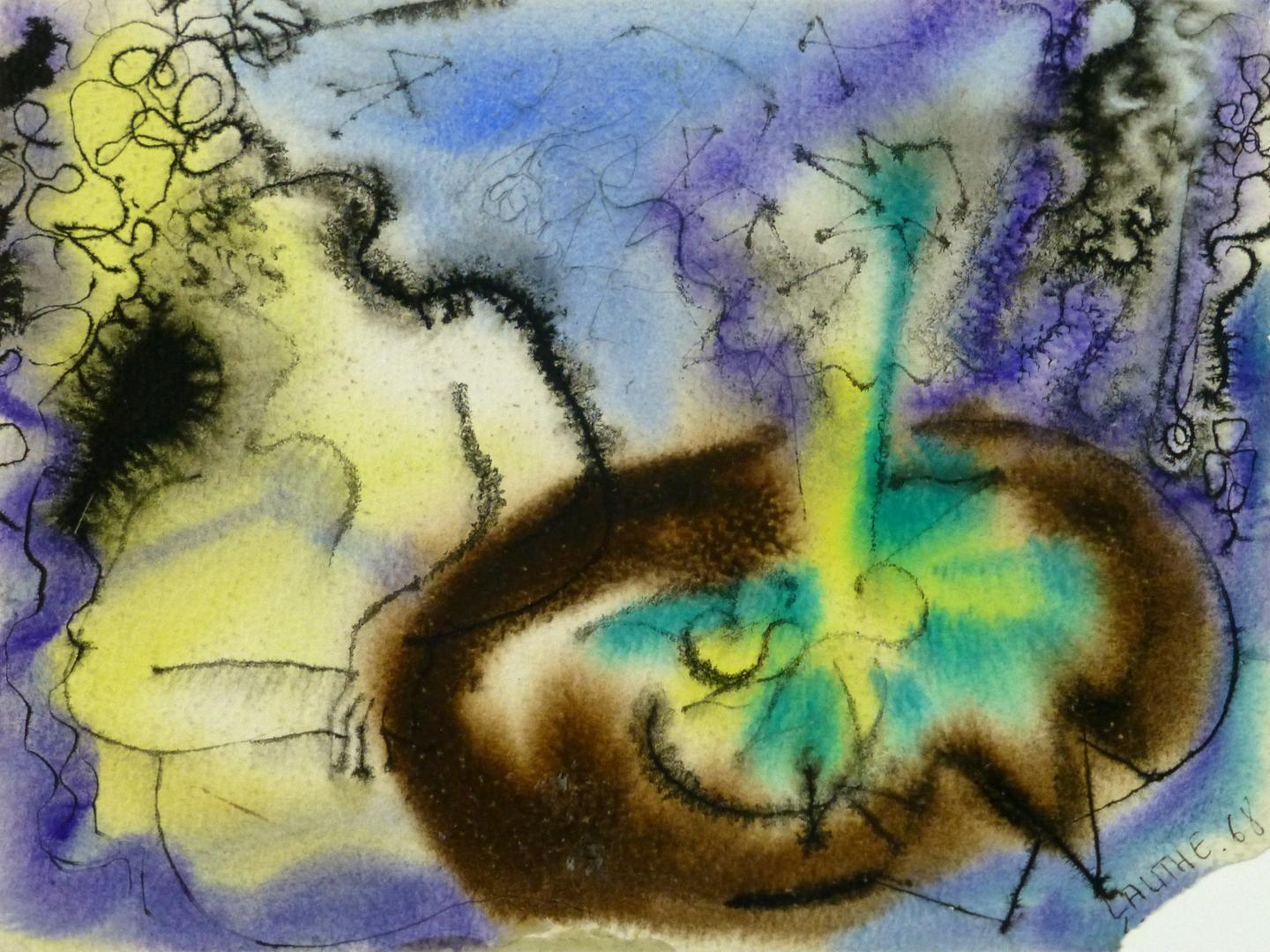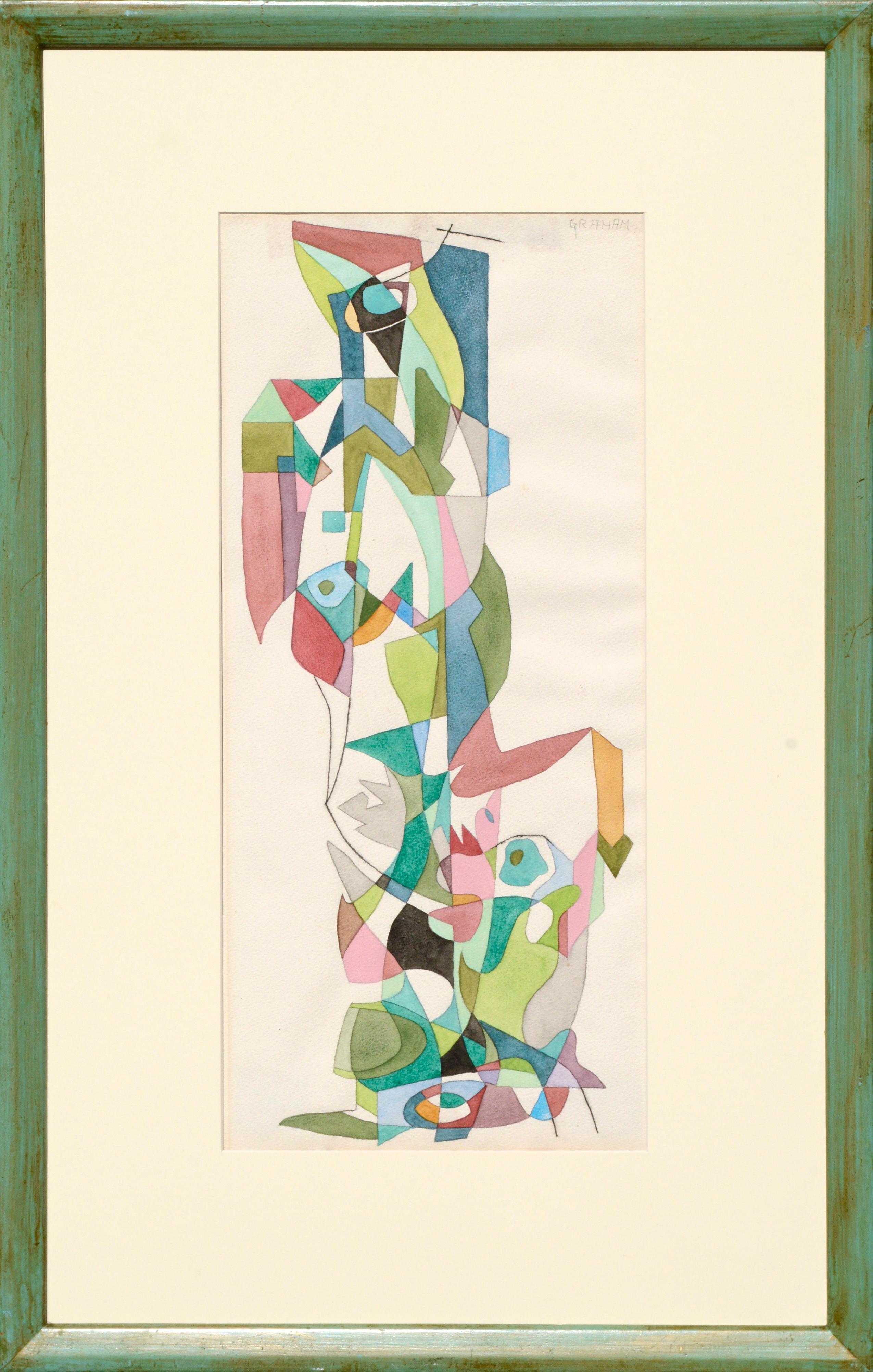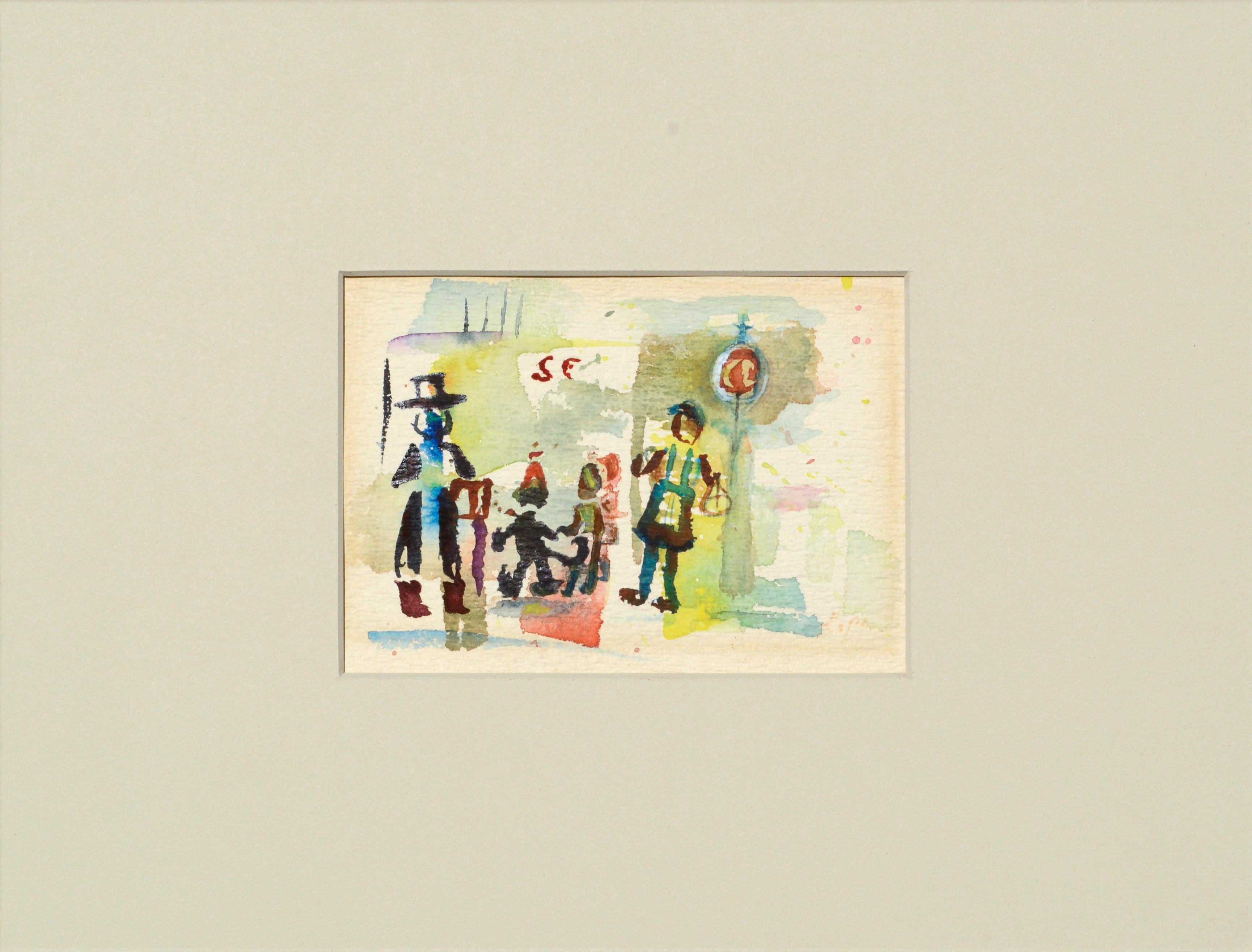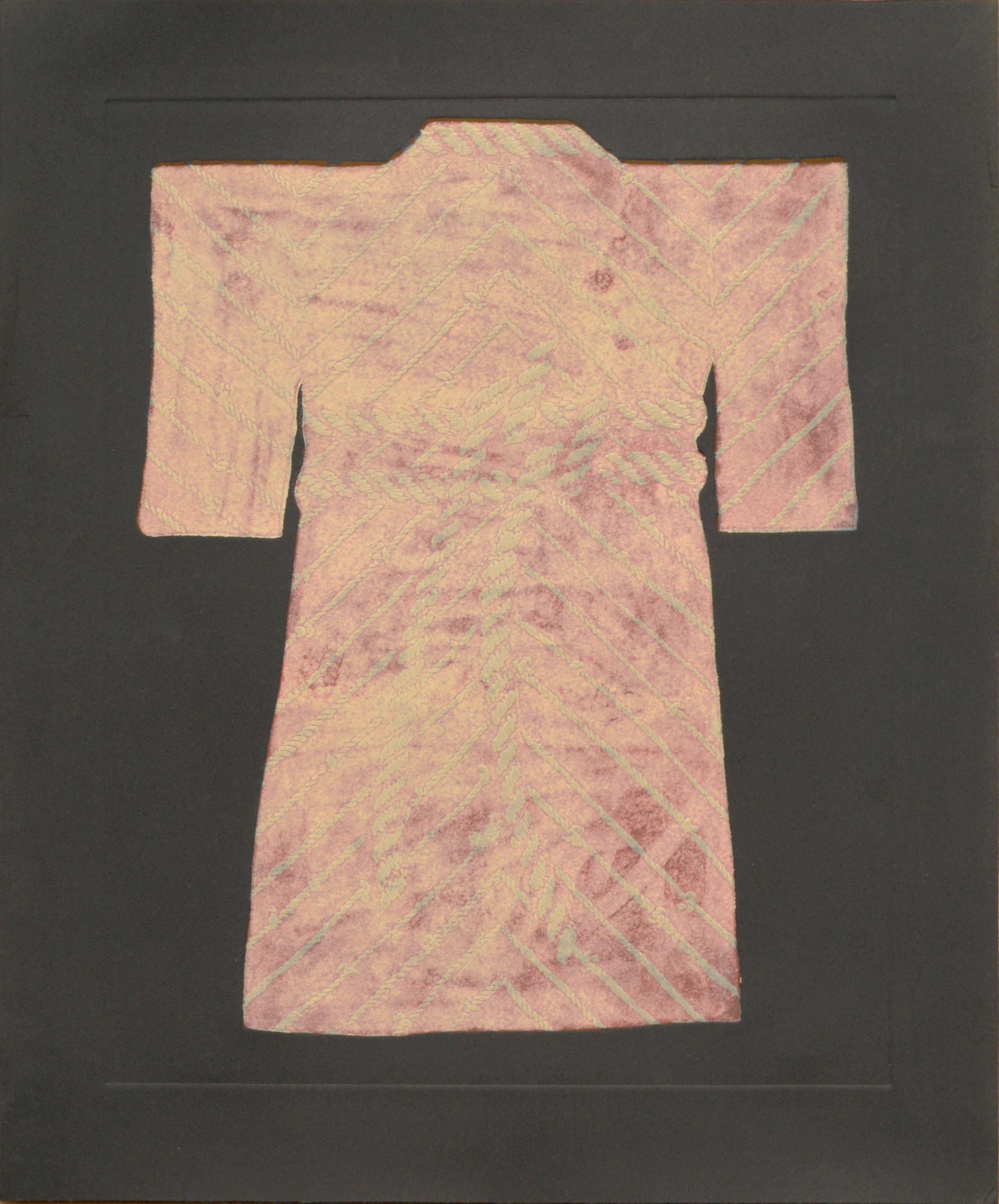Items Similar to Abstract Watercolor Painting, New Mexico Artist, Orange, Blue, Yellow, Gray
Video Loading
Want more images or videos?
Request additional images or videos from the seller
1 of 14
William LumpkinsAbstract Watercolor Painting, New Mexico Artist, Orange, Blue, Yellow, Gray1986
1986
About the Item
Abstract painting by New Mexico artist, William Lumpkins (1909-2000), painted in vivid colors of blue, orange, yellow, pink, gray, green, and black. Watercolor on paper, signed and dated 1986, lower center. Presented in a custom white gold leaf frame with all archival materials and UV protectant glass, outer dimensions measure 19 ¾ x 22 ½ inches. Image size is 11 x 13 ½ inches.
About the Artist:
William Lumpkins was born on Rabbit Ears Ranch, New Mexico in 1908. While he was raised in the west he was introduced to Zen Buddhism at a young age by a local farmer who had traveled to the east. This friendship would have a profound effect on Lumpkins for his entire life and greatly influenced his approach to his art. In 1929, he enrolled at the University of New Mexico (UNM) in Albuquerque. It was at the university he met Peter Hurd and they spent time together sketching the southern New Mexico landscapes. Lumpkins took his first art classes at UNM and in one of the classes met the young painter Cady Wells. Cady Wells would later become known for his exquisite watercolors.
Lumpkins saw a John Marin watercolor exhibition in Taos in 1931 and after this time he proceeded to experiment in abstraction. He studied architecture at the University of Southern California and graduated from UNM in 1934. While at UNM, he met several artists including Stuart Walker and Robert Gribbroek who with Lumpkins belonged to the Transcendental Painting Group founded in Santa Fe, New Mexico in 1938.
In 1939, he opened a private architectural firm in Santa Fe and after time in the Navy, he reestablished his firm in Santa Fe in 1946. Lumpkins received many honors for his architectural work but he continued to create his watercolors almost every day.
It is his watercolors that his best known for and a medium he mastered. Lumpkins painted with an unforced ease and spontaneity which was influenced by his reading Zen koans (small books of wise verse). He had an inner spiritual harmony that is reflected in his artwork. He was known to say that painting was the opposite discipline of the rigid tenets of architecture and an area he could be most expressive. Lumpkins is considered the most instinctive painter of the TPG group. He continued to create watercolors for decades after the TPG disbanded in 1942 in his studio home in Santa Fe. ©David Cook Galleries, LLC
- Creator:William Lumpkins (1909-2000, American)
- Creation Year:1986
- Dimensions:Height: 19.75 in (50.17 cm)Width: 22.5 in (57.15 cm)Depth: 1 in (2.54 cm)
- Medium:
- Movement & Style:
- Period:
- Condition:very good to excellent vintage condition. Frame, mat and glass have recently been added.
- Gallery Location:Denver, CO
- Reference Number:
About the Seller
5.0
Platinum Seller
These expertly vetted sellers are 1stDibs' most experienced sellers and are rated highest by our customers.
Established in 1979
1stDibs seller since 2013
264 sales on 1stDibs
Typical response time: 5 hours
- ShippingRetrieving quote...Ships From: Denver, CO
- Return PolicyA return for this item may be initiated within 7 days of delivery.
More From This SellerView All
- American Modernist Abstract Mining Scene Watercolor Painting, Red Green BrownBy Frank Pancho GatesLocated in Denver, CO1935 American Modernist watercolor on paper by Frank "Pancho" Gates (1904-1998). An abstract scene of a mining town in the mountains, completed in colors of red, green, yellow, and black. Presented in a custom frame with all archival materials, outside dimensions measure 14 ¼ x 17 ¼ inches. Image size measures 8 ¾ x 11 ¾ inches. Painting is clean and in good condition, has had restoration work - please contact us for a detailed condition report. Expedited and international shipping is available - please contact us for a quote. About the Artist: A Colorado modernist artist and theater set designer, he grew up in Edgewater, Colorado, near the Manhattan Beach Theater and the winter quarters of the Denver Post’s Sells-Floto Circus which he frequented as a youngster. These two places introduced him early on to the theater. Additionally, his father toured the United States in a wire walking act with the Barnum and Bailey Circus. Gates began his association with the theater in 1919 when just out of high school. He initially worked with scenic artist, Jack Stein, at the old Tabor Theater in the Tabor Grand Opera House (demolished in 1964) in downtown Denver. Soon after that, he became an assistant scenic artist to George Bradford Ashworth, a famous New York stage set designer, who during the summer designed sets for the Elitch Gardens Theater in northwest Denver. Gates later produced the sets there until 1928. He was offered a scholarship to Colorado A & M College (now Colorado State University) in Fort Collins but declined because of his growing commitment to the theater. He followed his tenure at Elitch’s with positions at the Denham Theater in Denver and the Palm Theater in Pueblo. Upon returning to Denver, he became a free-lance artist for studios producing scenery for stage shows at the city’s Tabor, Denver, Paramount, Alladin, Rivoli, Broadway, Orpheum and Empress Theaters. He moved to California, perfecting his craft at the Pasadena Playhouse, a training school for young actors and actresses pursuing stardom in the movies. Later associated with the Technicolor Corporation, he helped to produce the film used in early color movies such as Becky Sharp (1935) and the Garden of Allah...Category
1930s Abstract Abstract Drawings and Watercolors
MaterialsWatercolor, Archival Paper
- Figurative Watercolor Painting of Navajo Family with Orange, Brown, and GreenBy Lloyd MoylanLocated in Denver, COUntitled (Navajo Family) is a watercolor on paper painting of four female figures and an infant by 20th Century artist Lloyd Moylan in orange, brown, and green. Presented in a custom gold frame, outer dimensions measure 28 ⅜ x 22 ¼ x 1 ¾ inches. Image sight size is 20 ⅞ x 14 ⅞ inches. Painting is clean and in very good vintage condition - please contact us for a detailed condition report. Provenance: Private collection, Denver, Colorado Expedited and international shipping is available - please contact us for a quote. About the Artist: From St. Paul, Minnesota, Lloyd Moylan was a painter who specialized in Southwest Indian...Category
20th Century American Modern Figurative Drawings and Watercolors
MaterialsPaper, Watercolor
- 1970s Two Figures, Black Pen Ink Drawing , American Modern Semi-Abstract FiguresLocated in Denver, COUntitled (Two Figures) is a pen on paper drawing by Edgar Britton (1901-1982). Presented in a custom black frame, outer dimensions measure 13 ⅝ x 16 ⅝ x 1 inches. Image size is 9 x 1...Category
20th Century Abstract Figurative Drawings and Watercolors
MaterialsPen
- 1950s Abstract Composition in Brown, Orange and Blue with Black Parallel LinesBy Herbert BayerLocated in Denver, COWatercolor and ink on paper of an abstract composition of brown, orange and blue shapes between black parallel lines throughout the the piece by Herbert Bayer (1900-1985). Presented in a custom black frame with all archival materials. Framed dimensions measure 17 ⅞ x 22 ⅝ x 1 inches. Image size is 10 ¼ x 15 ½ inches. Painting is clean and in very good condition - please contact us for a detailed condition report. Expedited and international shipping is available - please contact us for a quote. About the Artist: Herbert Bayer enjoyed a versatile sixty-year career spanning Europe and America that included abstract and surrealist painting, sculpture, environmental art, industrial design, architecture, murals, graphic design, lithography, photography and tapestry. He was one of the few “total artists” of the twentieth century, producing works that “expressed the needs of an industrial age as well as mirroring the advanced tendencies of the avant-garde.” One of four children of a tax revenue officer growing up in a village in the Austrian Salzkammergut Lake region, Bayer developed a love of nature and a life-long attachment to the mountains. A devotee of the Vienna Secession and the Vienna Workshops (Wiener Werkstätte) whose style influenced Bauhaus craftsmen in the 1920s, his dream of studying at the Academy of Art in Vienna was dashed at age seventeen by his father’s premature death. In 1919 Bayer began an apprenticeship with architect and designer, Georg Schmidthamer, where he produced his first typographic works. Later that same year he moved to Darmstadt, Germany, to work at the Mathildenhöhe Artists’ Colony with architect Emanuel Josef Margold of the Viennese School. As his working apprentice, Bayer first learned about the design of packages – something entirely new at the time – as well as the design of interiors and graphics of a decorative expressionist style, all of which later figured in his professional career. While at Darmstadt, he came across Wassily Kandinsky’s book, Concerning the Spiritual in Art, and learned of the new art school, the Weimar Bauhaus, in which he enrolled in 1921. He initially attended Johannes Itten’s preliminary course, followed by Wassily Kandinsky’s workshop on mural painting. Bayer later recalled, “The early years at the Bauhaus in Weimar became the formative experience of my subsequent work.” Following graduation in 1925, he was appointed head of the newly-created workshop for print and advertising at the Dessau Bauhaus that also produced the school’s own print works. During this time he designed the “Universal” typeface emphasizing legibility by removing the ornaments from letterforms (serifs). Three years later he left the Bauhaus to focus more on his own artwork, moving to Berlin where he worked as a graphic designer in advertising and as an artistic director of the Dorland Studio advertising agency. (Forty years later he designed a vast traveling exhibition, catalog and poster -- 50 Jahre Bauhaus -- shown in Germany, South America, Japan, Canada and the United States.) In pre-World War II Berlin he also pursued the design of exhibitions, painting, photography and photomontage, and was art director of Vogue magazine in Paris. On account of his previous association with the Bauhaus, the German Nazis removed his paintings from German museums and included him among the artists in a large exhibition entitled Degenerate Art (Entartete Kunst) that toured German and Austrian museums in 1937. His inclusion in that exhibition and the worsening political conditions in Nazi Germany prompted him to travel to New York that year with Marcel Breuer, meeting with former Bauhaus colleagues, Walter Gropius and László Moholy-Nagy to explore the possibilities of employment after immigration to the United States. In 1938 Bayer permanently relocated to the United States, settling in New York where he had a long and distinguished career in practically every aspect of the graphic arts, working for drug companies, magazines, department stores, and industrial corporations. In 1938 he arranged the exhibition, “Bauhaus 1919-1928” at the Museum of Modern Art, followed later by “Road to Victory” (1942, directed by Edward Steichen), “Airways to Peace” (1943) and “Art in Progress” (1944). Bayer’s designs for “Modern Art in Advertising” (1945), an exhibition of the Container Corporation of America (CAA) at the Art Institute of Chicago, earned him the support and friendship of Walter Paepcke, the corporation’s president and chairman of the board. Paepcke, whose embrace of modern currents and design changed the look of American advertising and industry, hired him to move to Aspen, Colorado, in 1946 as a design consultant transforming the moribund mountain town into a ski resort and a cultural center. Over the next twenty-eight years he became an influential catalyst in the community as a painter, graphic designer, architect and landscape designer, also serving as a design consultant for the Aspen Cultural Center. In the summer of 1949 Bayer promoted through poster design and other design work Paepcke’s Goethe Bicentennial Convocation attended by 2,000 visitors to Aspen and highlighted by the participation of Albert Schweitzer, Arthur Rubenstein, Jose Ortega y Gasset and Thornton Wilder. The celebration, held in a tent designed by Finnish architect Eero Saarinen, led to the establishment that same year of the world-famous Aspen Music Festival and School regarded as one of the top classical music venues in the United States, and the Aspen Institute for Humanistic Studies in (now the Aspen Institute), promoting in Paepcke’s words “the cross fertilization of men’s minds.” In 1946 Bayer completed his first architecture design project in Aspen, the Sundeck Ski Restaurant, at an elevation of 11,300 feet on Ajax Mountain. Three years later he built his first studio on Red Mountain, followed by a home which he sold in 1953 to Robert O. Anderson, founder of the Atlantic Richfield Company who became very active in the Aspen Institute. Bayer later designed Anderson’s terrace home in Aspen (1962) and a private chapel for the Anderson family in Valley Hondo, New Mexico (1963). Transplanting German Bauhaus design to the Colorado Rockies, Bayer created along with associate architect, Fredric Benedict, a series of buildings for the modern Aspen Institute complex: Koch Seminar Building (1952), Aspen Meadows guest chalets and Center Building (both 1954), Health Center and Aspen Meadows Restaurant (Copper Kettle, both 1955). For the grounds of the Aspen Institute in 1955 Bayer executed the Marble Garden and conceived the Grass Mound, the first recorded “earthwork” environment In 1973-74 he completed Anderson Park for the Institute, a continuation of his fascination with environmental earth art. In 1961 he designed the Walter Paepcke Auditorium and Memorial Building, completing three years later his most ambitious and original design project – the Musical Festival Tent for the Music Associates of Aspen. (In 2000 the tent was replaced with a design by Harry Teague.) One of Bayer’s ambitious plans from the 1950s, unrealized due to Paepcke’s death in 1960, was an architectural village on the outskirts of the Aspen Institute, featuring seventeen of the world’s most notable architects – Walter Gropius, Marcel Breuer, I.M. Pei, Minoru Yamasaki, Edward Durrell Stone and Phillip Johnson – who accepted his offer to design and build houses. Concurrent with Bayer’s design and consultant work while based in Aspen for almost thirty years, he continued painting, printmaking, and mural work. Shortly after relocating to Colorado, he further developed his “Mountains and Convolutions” series begun in Vermont in 1944, exploring nature’s fury and repose. Seeing mountains as “simplified forms reduced to sculptural surface in motion,” he executed in 1948 a series of seven two-color lithographs (edition of 90) for the Colorado Springs Fine Arts Center. Colorado’s multi-planal typography similarly inspired Verdure, a large mural commissioned by Walter Gropius for the Harkness Commons Building at Harvard University (1950), and a large exterior sgraffito mural for the Koch Seminar Building at the Aspen Institute (1953). Having exhausted by that time the subject matter of “Mountains and Convulsions,” Bayer returned to geometric abstractions which he pursued over the next three decades. In 1954 he started the “Linear Structure” series containing a richly-colored balance format with bands of sticks of continuously modulated colors. That same year he did a small group of paintings, “Forces of Time,” expressionist abstractions exploring the temporal dimension of nature’s seasonal molting. He also debuted a “Moon and Structure” series in which constructed, architectural form served as the underpinning for the elaboration of color variations and transformations. Geometric abstraction likewise appeared his free-standing metal sculpture, Kaleidoscreen (1957), a large experimental project for ALCOA (Aluminum Corporation of America) installed as an outdoor space divider on the Aspen Meadows in the Aspen Institute complex. Composed of seven prefabricated, multi-colored and textured panels, they could be turned ninety degrees to intersect and form a continuous plane in which the panels recomposed like pieces of a jigsaw puzzle. He similarly used prefabricated elements for Articulated Wall, a very tall free-standing sculpture commissioned for the Olympic Games in Mexico...Category
1950s Abstract Geometric Abstract Drawings and Watercolors
MaterialsPaper, Ink, Mixed Media, Watercolor
- 20th Century Framed and Signed Abstract Watercolor Painting, Orange, Pink, RedLocated in Denver, COPink, orange, and red abstract watercolor on paper by Lynn R. Wolfe (1917-2019). Signed by the artist in the lower left corner. Presented in a custom frame with all archival materials measuring 27 ½ x 34 ¼; image size is 22 ¼ x 30 inches. Provenance: Estate of the Artist, Lynn R. Wolfe Painting is in good condition - please contact us for a detailed condition report. About the Artist: Born 1917 Red Cloud, Nebraska Died 2019 Boulder, Colorado A versatile artist proficient in painting, sculpture, stained glass and mosaics, Wolfe grew up on his family’s dairy farm near Red Cloud, Nebraska. For much of his early life he was known as Bob until officially adopting the first name of Lynn in 1939. When he was six months old he contracted the "Spanish flu" in the 1918 influenza pandemic that stunted his growth, making him the smallest student in class. To compensate for his small stature, his family engaged a Black boxer to give him boxing lessons so he could always defend himself against any bullies he encountered at school. Before he started grade school in Red Cloud, one of his grandfathers - a Latin scholar - taught him how to read. His early connection with sculpture occurred when as a youngster he looked for clay in the sandpits near his home to mould figures, including a likeness of his older brother. Similarly, his adult interest in archaeology developed from their search for arrowheads brought to the surface after rainstorms on the family farm. As a teenager he read The Temple Warriors in Chichen Itza, Yucatan, by Earl and Ann Morris with illustrations by Jean Charlot. After World War II Charlot taught fresco painting and worked with Lawrence Barrett on several editions of lithographs at the Colorado Springs Fine Arts Center. In 1947 Wolfe served as Charlot’s chauffeur when he came up to lecture at the University of Colorado in Boulder (CU), and in appreciation received one of the artist’s etchings personally inscribed to him. Following graduation as valedictorian of his high school class, Wolfe enrolled in 1935 as an undergraduate on scholarship at the University of Nebraska at Lincoln, earning his B.A. degree in fine art in 1940. He studied art with Frederick Dwight Kirsch (himself a student of fellow Nebraska native Robert Henri at the Art Students League in New York) who served as Chairman of the Art Department and Director of the University Art Galleries – now the Sheldon Museum - until 1950 when he became director of the Des Moines Art Center. In Nebraska Wolfe painted representational scenes of local buildings such as grain elevators in a landscape setting and small-town street scenes with automobiles. It took Wolfe five years to earn his undergraduate degree because he worked while going to school. In his final year he worked to pay the taxes on the family farm to avoid foreclosure during the Great Depression. While at the University, he prepared fossils and did low relief sculptures of prehistoric animals for the Nebraska State Museum located in Morrill Hall on campus. He also participated in Pleistocene fossil digs in Nebraska and Texas. One of his first jobs after graduation was supervising fossil preparation in Lincoln by twenty-nine workers employed in a Depression-era project sponsored by the federal government. In 1939 he met his future wife Arlene at a sock hop at the University of Nebraska. His first impression of her was a "stunning blond across the room" with whom he shared an interest in the arts and travel. During World War II when she was living and working in Omaha, he proposed to her from New Guinea where he was stationed in the South Pacific. He said that he would take her to Florida if she married him. He later took her and their family on a number of trips to most of Europe, and to Morocco, Algeria, Turkey, China, Japan and Fiji. During the last year of the war he taught photo intelligence in Orlando, Florida, while stationed at the local Air Force base. Prior to the Japanese attack on Pearl Harbor and America’s entry into the war, he worked in the Engineer Corps doing color, texture and illusion. During the war he spent four years in the military, shipping out as a buck private and later advancing to the rank of captain. His classroom experience in Florida helped transition him at war’s end to the University of Nebraska where he taught art for two semesters to fellow intelligence officers studying there on the G.I. Bill. In the summer of 1946 he also was a visiting artist at the University of Alaska where he taught watercolor. In 1947 he relocated to CU in Boulder for his Master of Fine Arts degree on the G.I. Bill. As part of his application earning him a graduate fellowship, he included a photograph of his wife and himself in his captain’s uniform. He took painting and sculpture courses with Muriel Sibell Wolle...Category
Late 20th Century Abstract Abstract Drawings and Watercolors
MaterialsWatercolor, Archival Paper
- Gold Mining, Homestake Mine, South Dakota, 1940s Abstract Landscape WatercolorLocated in Denver, COGouache and watercolor on paper painting, painted in 1948 by Mary Chenoweth (1918-1999). Signed and dated by the artist in the lower right corner. Depicting an abstracted landscape o...Category
1940s Abstract Abstract Drawings and Watercolors
MaterialsWatercolor, Gouache, Archival Paper
You May Also Like
- Water Color Abstract - Figures at the TableBy Jean-Charles LautheLocated in Houston, TXFrench painting in bright green, blue and yellow tones of someone sitting at a table by artist Jean-Charles Lauthe, 1971. Signed and dated lower right. Original artwork on paper dis...Category
1960s Abstract Abstract Drawings and Watercolors
MaterialsWatercolor, Paper
- "Indian Dance", Multicolor Abstract Geometric CompositionBy Ellwood GrahamLocated in Soquel, CABright and colorful abstract geometric watercolor with multicolor connected forms cascading in a dynamic vertical composition by Ellwood Graham (American, 1911-2007). Signed "GRAHAM" in the upper right corner, and "Ellwood Graham" on verso. Circa 1961-1966. The title "Indian Dance...Category
1960s Abstract Geometric Abstract Drawings and Watercolors
MaterialsPaper, Watercolor, Pen, Pencil
- Sea Creatures Abstract WatercolorBy Les AndersonLocated in Soquel, CAVibrant and fun figurative abstract of creatures on the ocean floor by Les (Leslie Luverne) Anderson (American, 1928-2009). From the estate of Les Anderson in Monterey, California. U...Category
1980s Abstract Expressionist Abstract Drawings and Watercolors
MaterialsPaper, Watercolor
- "The Hurdy Gurdy Man", Colorful Figurative Abstract Street Performer WatercolorBy Hope TepleyLocated in Soquel, CABrightly colored watercolor of a 1970's California street performer, done in a colorful, expressive slap-dash style, by Hope Tepley (American, 1919-2010). Signed "Tepley" in the lower right corner. Titled "The Hurdy Gurdy...Category
1970s Abstract Expressionist Figurative Drawings and Watercolors
MaterialsPaper, Watercolor
- Pink Rope KimonoBy Patricia A. PearceLocated in Soquel, CAMulti-layered collotype by Patricia A. Pearce (American, b. 1948). This piece is unsigned, but was acquired with a collection of other Pearce work. No frame. Patricia Pearce (Americ...Category
1980s Abstract Impressionist Abstract Drawings and Watercolors
MaterialsPaper, Ink, Gouache, Lithograph
- "Sacred" Angel Abstract Figurative Portrait with Snake, Bird, and Fish PaintingLocated in Houston, TXBeautifully executed watercolor painting by Joanna Ballard that depicts a nude angel standing over a resting figure. The composition includes many diverse hues that range in opacity....Category
1970s Abstract Abstract Drawings and Watercolors
MaterialsPaper, Watercolor
Recently Viewed
View AllMore Ways To Browse
Mexico Artist
Mexican Artists
Mexican Artist
New Mexico
New Mexican
Art By Mexican Artist
New Mexico Artists
New Mexican Artist
Blue And Gray Painting
Mexican Artist Painting
Mexican Artist Paintings
New Mexico Paintings
Mexico Abstract
Mexican Abstract Artist
Drawings Mexico
New Mexico Abstract
Custom Painting Signed By Artist
Sign New Mexico




